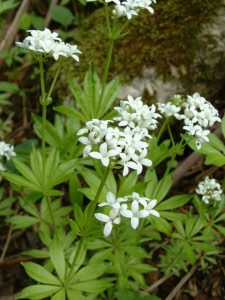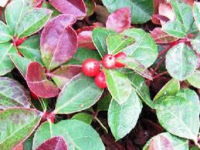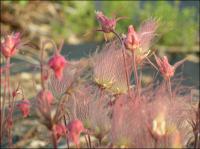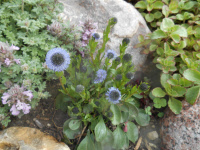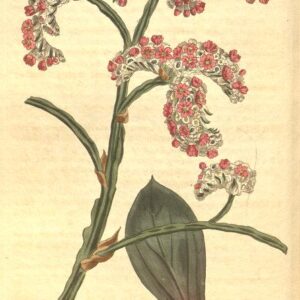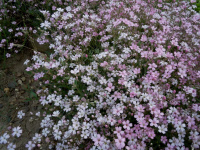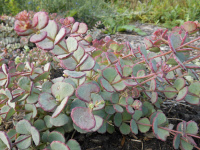Alpine, Rock, Miniature, Bonsai and Railroad Gardens
Showing 41–48 of 85 results
-
Galium odoratum Sweet woodruff, Bedstraw Z 4-8
Whorls of fine textured leaves, like spokes of a wheel, with white blooms in spring lighting up the shade
Whorls of fine textured leaves, like spokes of a wheel, with white blooms in spring lighting up the shade
Size: 6-12" x 18" spreading
Care: shade to part shade in moist to moist well-drained soil.
Native: Europe and Mediterranean areaCalled “Bedstraw” because, according to legend, Mary rested on hay of Bedstraw on Christmas. May wine made an ancient herbal remedy: handful of dried and crushed leaves plus fresh lemon juice steeped in wine for 3-4 hours “makes a man merry and (is) good for the heart and liver.” Garlands hanging in houses in summer “coole and make fresh the place, to the delight and comfort of such as are therein.” per English herbalist Gerard, 1633. Dried branches give a grassy vanilla fragrance, used in sachets and potpourris, as an insect repellant and to make grey-green dyes.
-
Gaultheria procumbens Wintergreen, Checkerberry, Teaberry Z 3-8
“Gaultheria procumbens is in absolute perfection and beautiful – first as regards its bell-shaped blossoms, and afterwards its berries…” The Garden January 1876.
OUT OF STOCK
“Gaultheria procumbens is in absolute perfection and beautiful – first as regards its bell-shaped blossoms, and afterwards its berries…” The Garden , January 1876.
Size: 4” x 2’, spreading slowly - will make dense groundcover in time.
Care: part shade in moist to moist well-drained, acidic soil
Native: Eastern North America – Canada to Georgia west to Wisconsin
Awards: England’s Royal Horticultural Society Award of Merit.Ojibwa made tea from the leaves; the tea “makes them feel good.” Oneida used this for women having a painful menstrual cycle. For the Algonquin Wintergreen cured the common cold, headaches, grippe and stomachaches. Cherokee cured swollen gums and colds. Berries described as a grape in 1717. Named by Swedish botanist Peter Kalm after Dr. Gaulthier, with whom he botanized in Canada in 1749. Sold in America’s 1st plant catalog, Bartram’s Broadside, 1783. During the American Revolution when tea became unavailable, colonists used the plant to make tea. The tea reputedly relieved pain from headaches, muscle pains and colds. The leaves contain oil effective against pain – methyl salicylate. Pressed specimen in Emily Dickinson’s herbarium.
-
Geum triflorum Prairie smoke, Old Man’s whiskers Z 3-7
Pale purplish-pink dangling cup-shaped flowers in spring to early summer, followed by hair-like, pink seed heads like the hair on a troll doll.
Pale purplish-pink dangling cup-shaped flowers in spring to early summer, followed by hair-like, pink seed heads like the hair on a troll doll.
Size: 10" x 8" but slow to grow to this width
Care: sun in well-drained to moist well-drained soil
Native: all of northern No. America, Wisconsin native
Wildlife Value: attracts butterflies, bees, wasps, and moths. Resists deer and rabbits.
Awards: Great Plants for Great PlainsIntroduced to gardens in 1609. Many Native American medicinal uses. Blackfeet used it to cure coughs, skin sores and wounds on people and horses, swollen eyes, canker sores, and fuzzy thinking in people. Crushed, ripe seeds made a perfume. Okanagan-Colville women made a love potion from the roots, as well as curing vaginal yeast infections. The Eastern Cascades of Canada brewed a medicinal tea for eye-wash, sore throats, and general aches from the plant. Sioux used it for many ailments: sore eyes, canker sores, sore throat, perfume, wounds, and added it to mixtures of plants for smoking. Collected by Meriwether Lewis on June 12, 1806 on the Weippe Prairie, not far from the villages of the Nez Perce in Idaho.
-
Globularia cordifolia Globe daisy, Wedge leaved globularia Z 5-9
Dense, blue, globe-shaped umbels in spring
OUT OF STOCK
Dense, blue, globe-shaped umbels in spring, mat forming, leathery, spoon-shaped leaves.
Size: 5” x 12”
Care: sun in well-drained soil
Native: alpine pastures in Switzerland and Pyrenees
Awards: Royal Horticultural Society Award of Merit.Collected before 1753. “The most desirable (Globularia) for the rockwork is the neat G. cordifolia which is a little prostrate trailing shrub with bluish flowers.” William Robinson 1879.
-
Globularia nudicaulis Globe daisy Z 3-8
Cobalt blue puffs on naked stems rise above compact rosettes of glossy oval leaves, May-June
Cobalt blue puffs on naked stems rise above compact rosettes of glossy oval leaves blooming May-June
Size: 4-8” x 4”
Care: Sun to part shade in well-drained soil. Drought tolerant/rock garden plant.
Native: northern Spain to the Pyrenees MountainsIn gardens before 1753
-
Goniolimon speciosum syn. Statice speciosa, Limonium Dwarf Statice Z 3-9
Evergreen, flat, agave-like blue-green rosette of leaves. In mid-summer light pink, flat-topped flower clusters held on leafless stems 10-12” above foliage. Very different, fun and easy to grow.
Evergreen, flat, agave-like blue-green rosette of leaves. In mid-summer light pink, flat-topped flower clusters held on leafless stems 10-12” above foliage. Very different, fun and easy to grow.
Size: 10-12’ X 8”
Care: sun in well-drained soil
Native: Steppes of Eurasia: Russia, Siberia, Mongolia & western ChinaCollected by German naturalist Johann Georg Gmelin (1709-1755)1st described in 1753 then named and renamed several times. Pictured in Curtis’s Botanical Magazine 18. No. 656 1803.
-
Gypsophila repens ‘Rosea’ Creeping baby’s breath Z 4-7
Tough but dainty appearing pink flowers on short, thin stems smother gray-green leaves from June to October. Excellent groundcover, front of the border or rock garden plant.
Tough but dainty appearing pink flowers on short, thin stems smother gray-green leaves from June to October. Excellent groundcover, front of the border or rock garden plant.
Size: 8" x 10-12"
Care: Full sun in well-drained soil.
Native: Mountains of central and southern EuropeGypso is Greek meaning “gypsum or lime.” Phylos means “loving.” Plant requires limey (alkaline) soil. Discovered in Siberia in 1774.
-
Hylotelephium sieboldii syn Sedum sieboldii, October Daphne Z 3-9
Fleshy gray-green foliage edged with pink encircles the prostrate stems, flowering strawberry pink in fall. Perfect for rock gardens, front of border, fairy gardens, roof gardens, troughs and groundcover or anyplace with drought.
Fleshy gray-green foliage edged with pink encircles the prostrate stems, flowering strawberry pink in fall. Perfect for rock gardens, front of border, fairy gardens, roof gardens, troughs and groundcover or anyplace with drought.
Size: 4" x 8"
Care: full sun in moderately fertile, well-drained soil.
Native: Japan
Wildlife Value: Drought tolerant and deer resistant.
Awards: Elisabeth Carey Miller Botanical Garden Great Plant PickSedum means “plant that sits.” “Live forever” is an ancient Greek name for sedums. The Roman Pliny claimed that sedum’s juice treated wounds. In the 1500’s English herbalist Gerard called sedums “very full of life,” referring to succulent’s quality of being very easy to grow. This species named for its discoverer, Dr. Philipp Franz von Siebold (1791-1866). Von Siebold, a German doctor, worked for the Dutch East India Company as its resident physician on Deshima Island, off the coast of Japan. He boldly became too knowledgeable about Japanese affairs and was imprisoned by the Japanese in 1826 and then banished in 1828. When he left he carried nearly 500 plants with him to Europe. William Robinson, father of the mixed perennial border, described Sedum sieboldii as beautiful. He advised gardeners to grow it “in strong loam and mortar rubble in fully exposed positions (and use it as) an excellent plant for vases in summer.”

